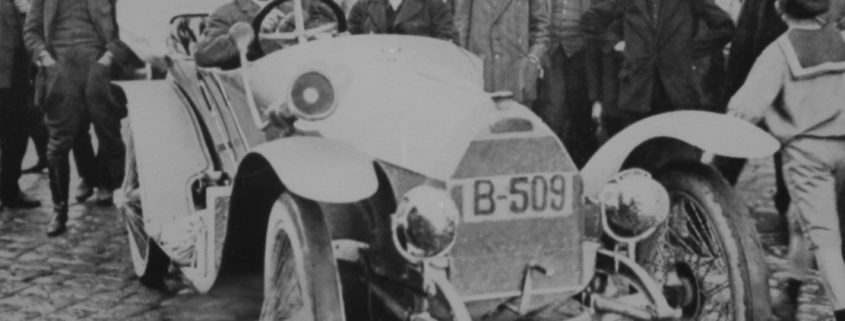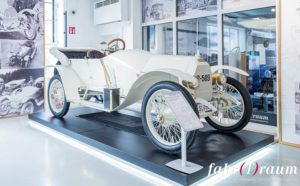Austro Daimler Alpenwagen Year of manufacture 1911 now at fahr(T)raum
The last surviving AD 9/27 Alpenwagen stands in Mattsee
The Ferdinand Porsche Erlebniswelten fahr(T)raum Mattsee/Salzburg is currently displaying an AD 9/27 HP Alpenwagen. This sports car – a successful further development of the AD 20 HP – is the only surviving car of this type; one other was destroyed in a fire.
In the autumn of 1910, Austro Daimler, under the technical direction of Ferdinand Porsche completed the Alpenwagen. Contrary to its predecessor, it featured the following technical details: larger valves, shorter inlet port, lighter connecting rods and pistons, an optimised outlet port and a perfectly balanced fly wheel with balancing machine.
Austro Daimler « Alpenwagen » at fahr(T)raum, Mattsee.
The Alpenwagen was manufactured from 1911 until 1922 and underwent extensive modifications to the AD 25 HP in 1918. There are no records about how many Alpenwagen were built in total; estimations range from 100 to 200 vehicles. The Old-timer Exhibition at fahr(T)raum is now presenting the last existing model. The displayed Alpenwagen was completely rebuilt under the guidance of Ernst Piëch and is now exhibited in an as-new condition.
The success of the Alpenwagen became evident as early as 1911, when it made its debut at the International Non Stop-Alpenfahrt. At that time, it was considered the most difficult, significant and publicity-attracting test drive for touring cars. The Alpenfahrt was an annual event from 1910 until 1914, organised by the K.K. Österreichischen Automobilclub.
During the drive in 1911, there had been four non-stop legs over a total of 1424 km and six alpine passes. The touring cars had to be in operation non-stop for four consecutive days – incredible even at today’s standards.
The first leg went for 315 km from Vienna to Aussee. The second leg went from Aussee to Trieste (404 km). The third leg comprised 303 km from Trieste to Klagenfurt. The fourth and last leg went from Klagenfurt back to Vienna over a distance of 404 km. The motor was not allowed to stop throughout the entire drive; otherwise, penalty points were awarded. The Austro Daimler factory team with the pilots Ferdinand Porsche, Eduard Fischer and Heinrich Graf Schönfeld absolved the entire race without penalty points and won the large gold medal.
Quellen
Bildnachweis
Foto Alpenwagen © Taro Ebihara
Das könnte Sie auch interessieren:








Ferdinand Porsche at Austro-Daimler – Career highlights
/dans Geschichte, Lebensstationen, Non classifié(e), Rennautos, Sonstige FahrzeugeFollowing the departure of Paul Daimler from the Austro-Daimler plants in Wiener Neustadt in 1905 – he replaced Wilhelm Maybach in the design office in Stuttgart – Emil Jellinek, diplomat and businessman, participated in the company. He transformed what he considered the « obsolete » plant into a modern car factory and brought a brilliant young engineer […]
Auto Union Type C – most successful German Grand Prix racing car in 1936!
/dans Geschichte, Motoren, Non classifié(e), RennautosThe Auto Union Type C was the most successful German Grand Prix racing car in 1936. It won three out of five Grand Prix races, half of the circuit races and all hill-climbs in which Auto Union participated. In addition, the Type C set more than thirty world records. In order to minimise the financial […]
NEW at fahr(T)raum: Steyr Type 30 Cabriolet (1931)
/dans Geschichte, Non classifié(e), Sonstige FahrzeugeFerdinand Porsche, who has gone down in history as a pioneer of automotive engineering, developed a car for the upper middle class for the Steyr-Werke in 1929: following his career as Technical Director at Austro Daimler (1906-1923). He very advantageously reengineered, as instructed by Steyr, the Steyr type XX and created a substantially new model […]